〖大前端 - 基础入门三大核心之JS篇(55)〗- 内置对象
- 说明:该文属于 大前端全栈架构白宝书专栏,目前阶段免费,如需要项目实战或者是体系化资源,文末名片加V!
- 作者:哈哥撩编程,十余年工作经验, 从事过全栈研发、产品经理等工作,目前在公司担任研发部门CTO。
- 荣誉:2022年度博客之星Top4、2023年度超级个体得主、谷歌与亚马逊开发者大会特约speaker、全栈领域优质创作者。
- 🏆 白宝书系列

文章目录
? 包装类
很多编程语言都有“包装类”的设计,包装类的目的就是为了让基本类型值可以从它们的构造函数propotype上获得方法
Number()、String()和Boolean()分别是数字、字符串、布尔值的“包装类”
- 用
new 包装类()得到的变量的类型是对象,是一种特殊的表现形式。比如一个数字123用包装类进行“包装”,就会得到一个被“包装”了的{123},示例代码如下:
var a = new Number(123);
var b = new String('哈士奇');
var c = new Boolean(true);
console.log(a);
console.log(typeof (a)); // object
console.log(b);
console.log(typeof (b)); // object
console.log(c);
console.log(typeof (c)); // object
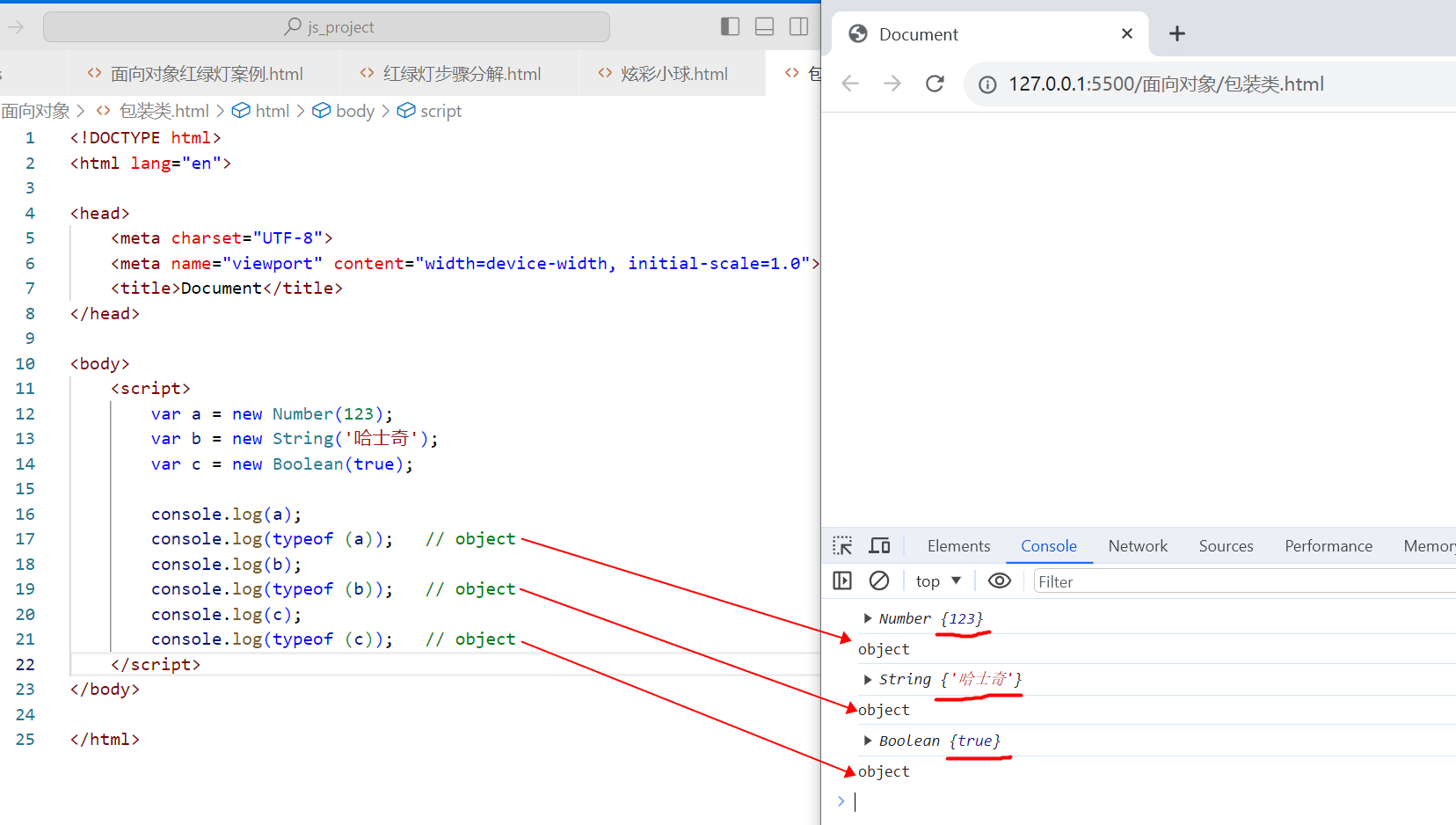
- 包装类new出来的虽然是一个对象,但依然可以像普通类型一样可以进行计算、切片或布尔判断等
示例代码:
var a = new Number(123);
var b = new String('哈士奇');
var c = new Boolean(true);
console.log(2 + a); // 125
console.log(b.slice(0, 2)); // '哈士'
console.log(c && true); // true
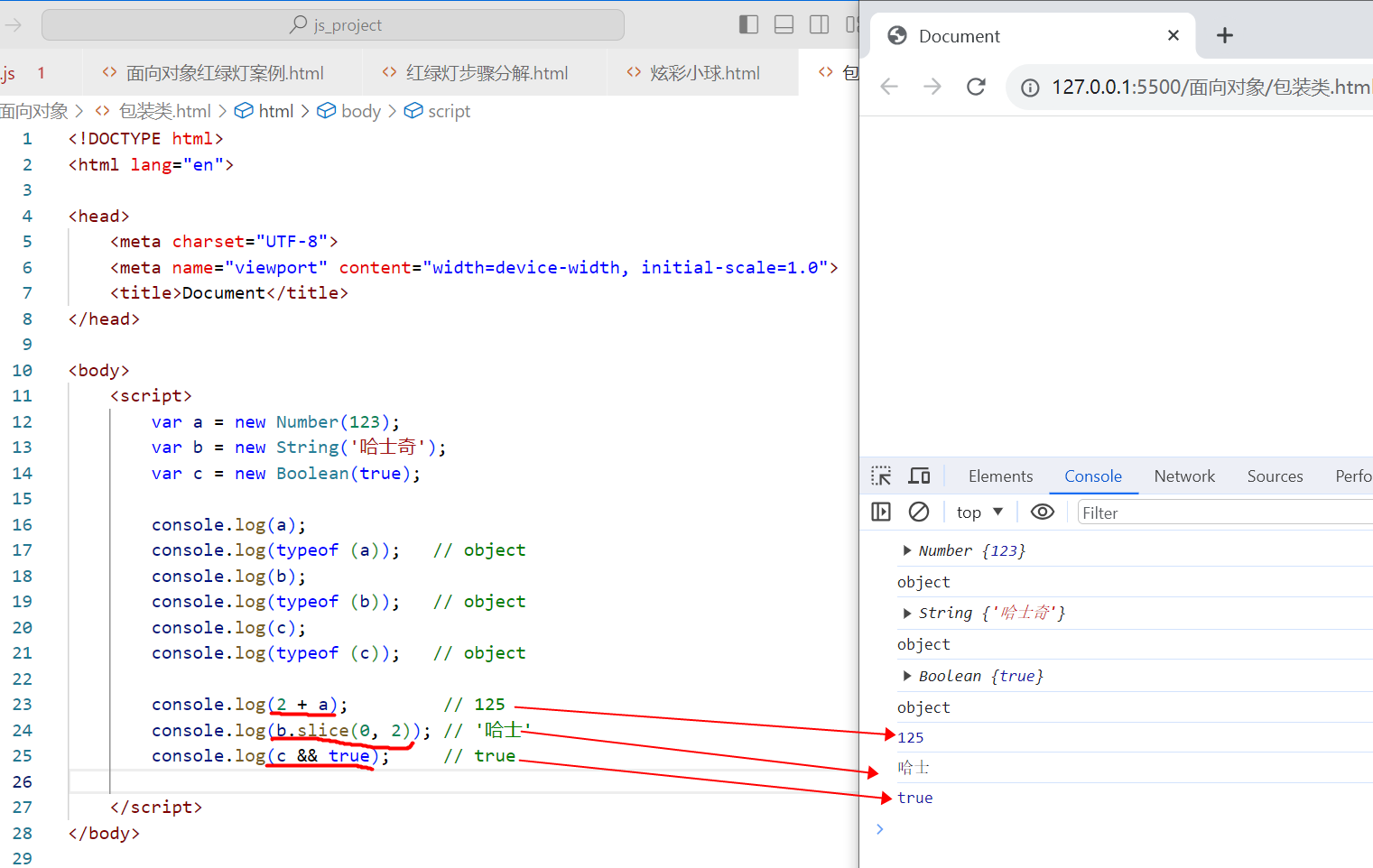
- 我们定义一个
number类型的变量,它的原型就是Number包装类的prototype。也就是说我们定义的number类型的变量可以看作是Number()new出来的。这就是为什么我们基本类型值可以调用一些内置的方法,比如字符串可以直接调用slice()方法、str()方法等
示例代码:
var d = 123;
console.log(d.__proto__ === Number.prototype); // true,证明变量d是Number new出来的实例
var e = '哈士奇';
console.log(e.__proto__ === String.prototype); // true,证明变量e是String new出来的实例
console.log(String.prototype.hasOwnProperty('slice')); // true
// 因为变量e是String() new出来的实例,所有变量e可以调用String.prototype拥有slice方法
console.log(e.slice(0, 2));
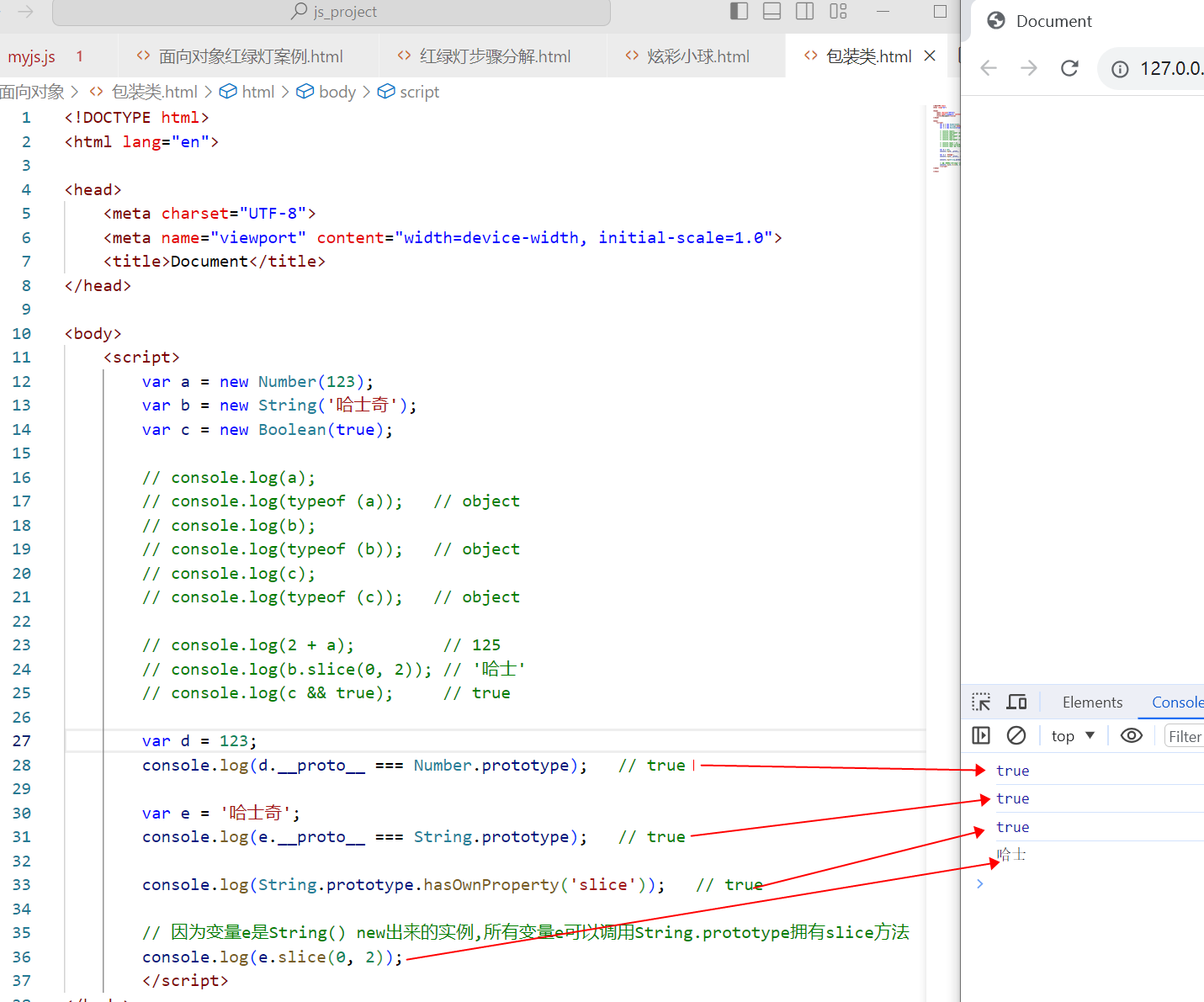
包装类的目的就是为了让基本类型值可以从它们的构造函数prototype上获得方法,这就是js设计包装类的初衷。
注意,包装类是对基本类型值的面向对象封装,像对array这种复杂类型的封装就不能叫做包装类了,undefined和null是没有包装类的
? Math(数学)对象
🌟 Math.round()
Math.round() 可以将一个数字四舍五入为整数
console.log(Math.round(4.56)); // 5
console.log(Math.round(1.49)); // 1
console.log(Math.round(-12.2345)); // -12

- 利用
Math.round()实现四舍五入到小数点后某位:

示例代码:
var a = 1.2672;
console.log(Math.round(a * 100) / 100); // 1.27
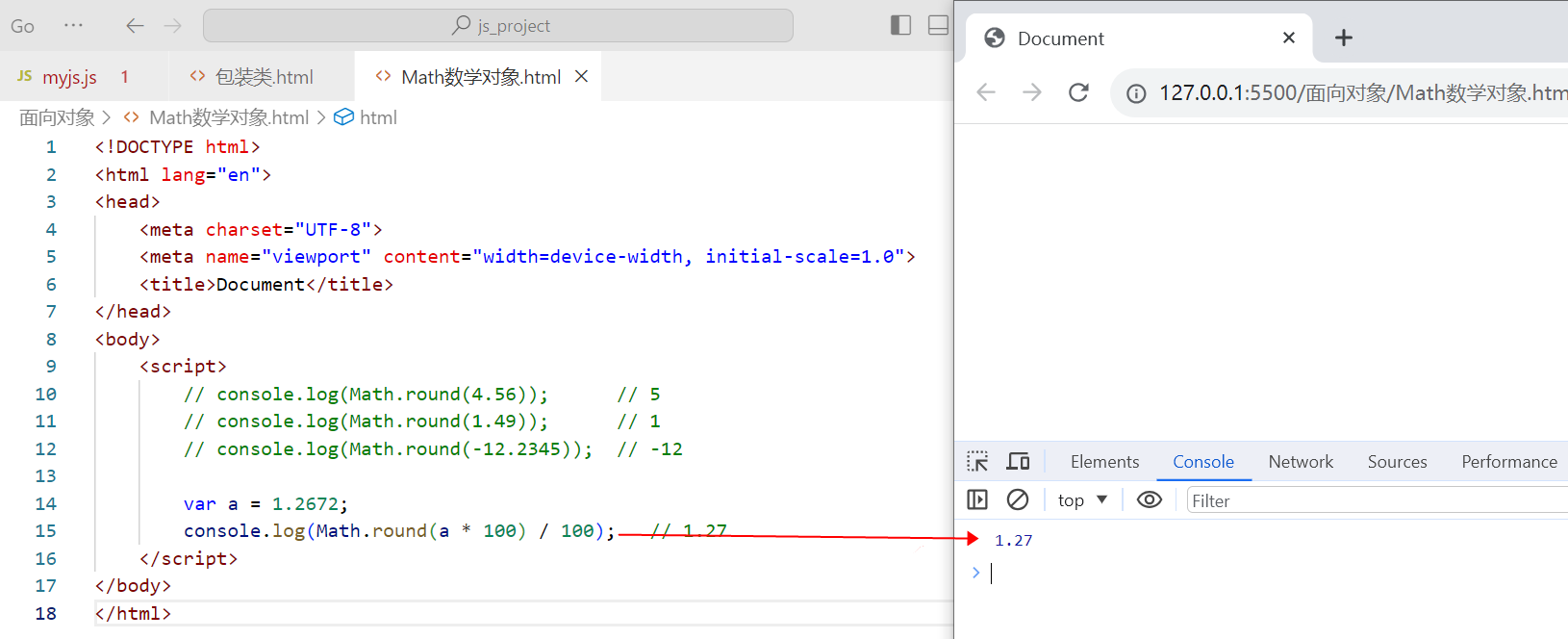
🌟 Math.max()和Math.min()
Math.max() 可以得到参数列表的最大值
Math.min() 可以得到参数列表的最小值
console.log(Math.max(2, 4, 6, 8)); // 8
console.log(Math.min(2, 4, 6, 8)); // 2

-
利用
Math.max()和Math.min()得到数组中的最大值和最小值:因为
Math.max()和Math.min()要求参数必须是“罗列”出来,而不能是数组,我们可以利用apply方法(apply方法可以指定函数的上下文,并且以数组的形式传入“零散值”当作函数的参数),将数组以“零散值”的方式传入函数。示例代码:
var arr = [2, 4, 6, 8]; console.log(Math.max.apply(null, arr)); // 8 console.log(Math.min.apply(null, arr)); // 2 // 在ES6中,还可以使用“...”运算符来将数组变成零散值传入函数 console.log(Math.max(...arr)); // 8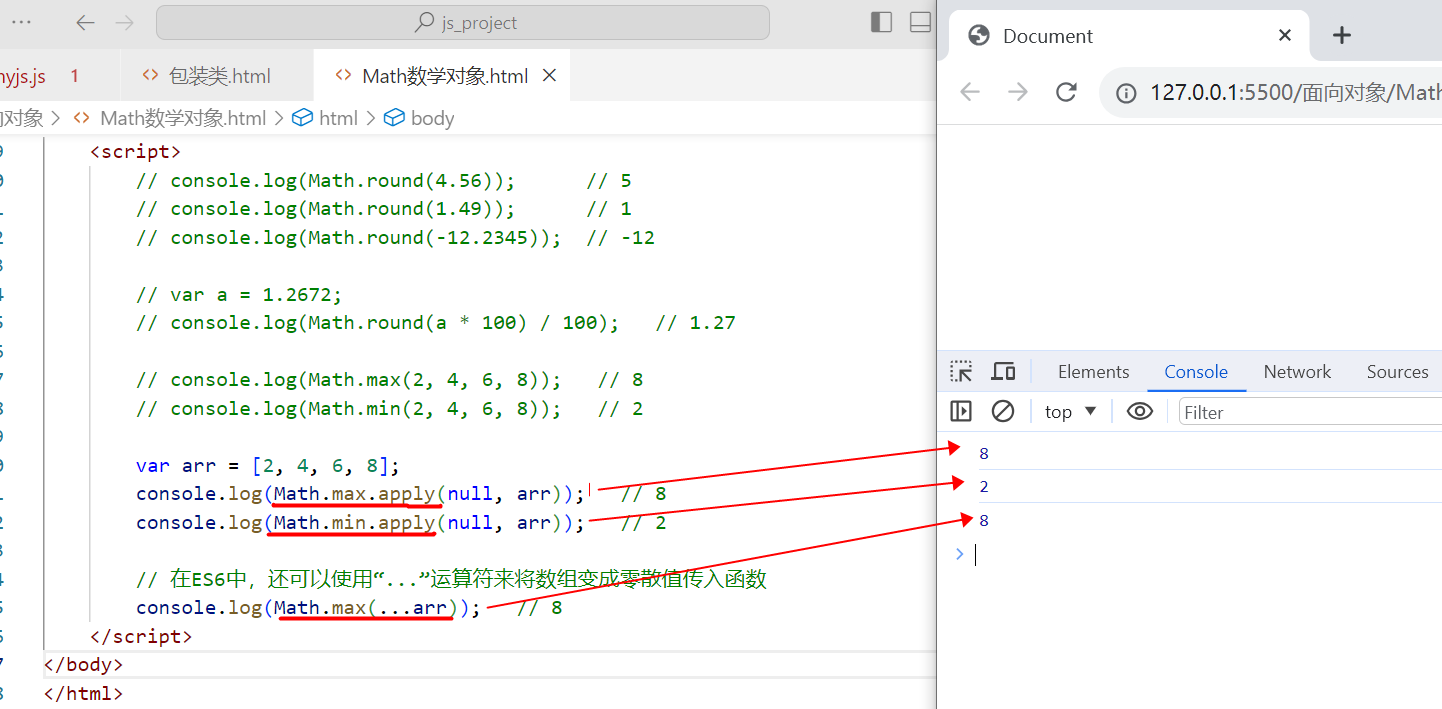
🌟 Math.random()
Math.random() 可以得到0~1之间的小数
为了得到[a, b]区间内的整数,可以使用这个公式:paseInt(Math.random() * (b - a + 1)) - a
// 随机数
console.log(Math.random());
console.log(Math.random());
console.log(Math.random());
// 生成[10~20]之间的整数,公式parseInt(Math.random() * (b - a + 1)) + a
console.log(parseInt(Math.random() * 11) + 10);

? Date(日期)对象
🌟 创建日期对象
使用new Date() 可以得到当前日期,是object类型值
使用new Date(2024, 12, 1)即可得到指定日期的日期对象,注意:第二个参数表示月份,从0开始算,11表示12月;也可以用new Date(‘2024-12-01’)这样的写法
// 获取当前日期对象
var d_now = new Date();
console.log(d_now); // 当前时间
console.log(typeof d_now);
// 获取指定日期对象
var d1 = new Date(2024, 2, 1); // 不算时区
var d2 = new Date('2024-06-01'); // 算时区,我们位于东八区,所以是上午8点
console.log(d1);
console.log(d2);
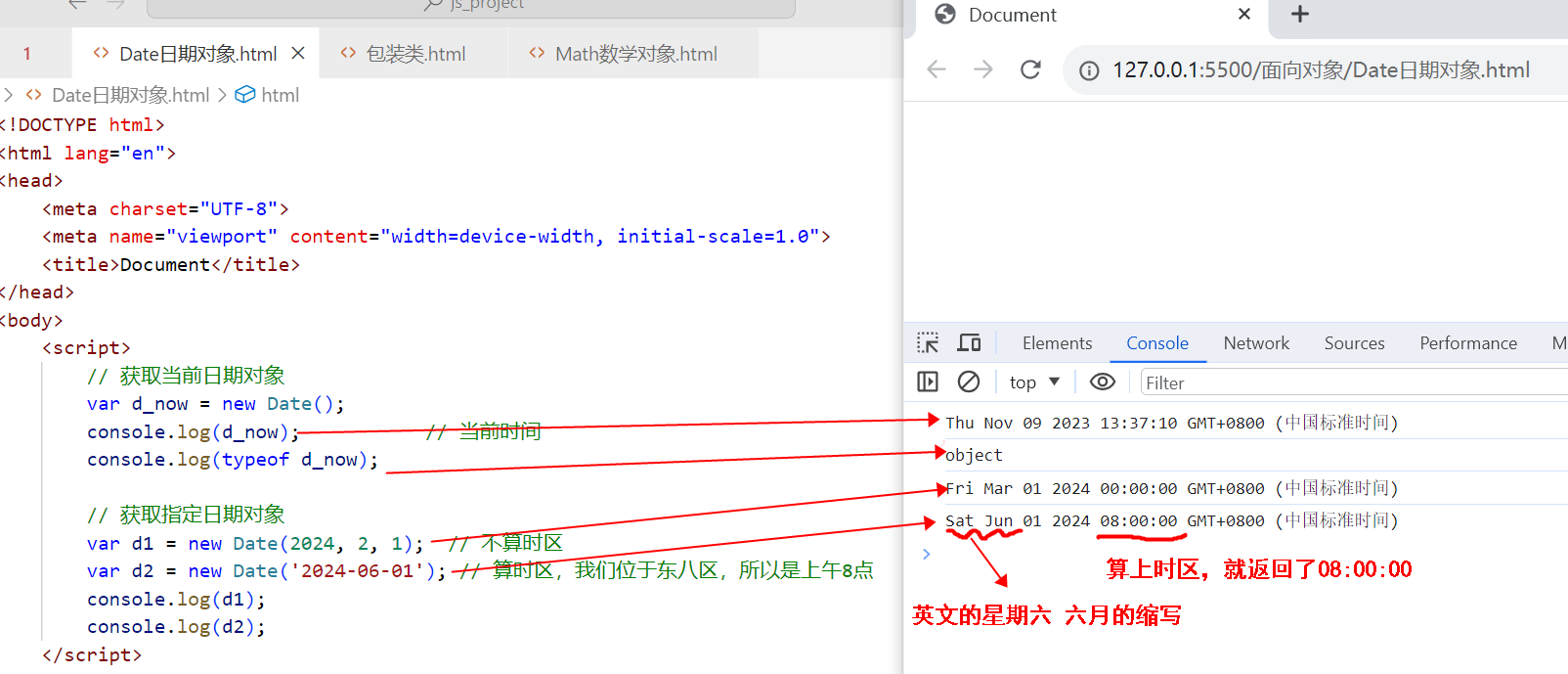
🌟 日期对象的常见方法
日期对象的常见方法:
| 方法 | 功能 |
|---|---|
| getDate() | 得到日期1~31 |
| getDay() | 得到星期0~6 |
| getMonth() | 得到月份0~11 |
| getFullYear() | 得到年份 |
| getHours() | 得到小时数0~23 |
| getMinutes() | 得到分钟数0~59 |
| getSeconds() | 得到秒数0~59 |
示例代码:
var d = new Date();
console.log('日期', d.getDate());
console.log('星期', d.getDay());
console.log('月', d.getMonth()); // 注意因为月份是从0开始算的,如果得到的是10,则表示现在是11月份
console.log('年份', d.getFullYear());
console.log('时', d.getHours());
console.log('分', d.getMinutes());
console.log('秒', d.getSeconds());
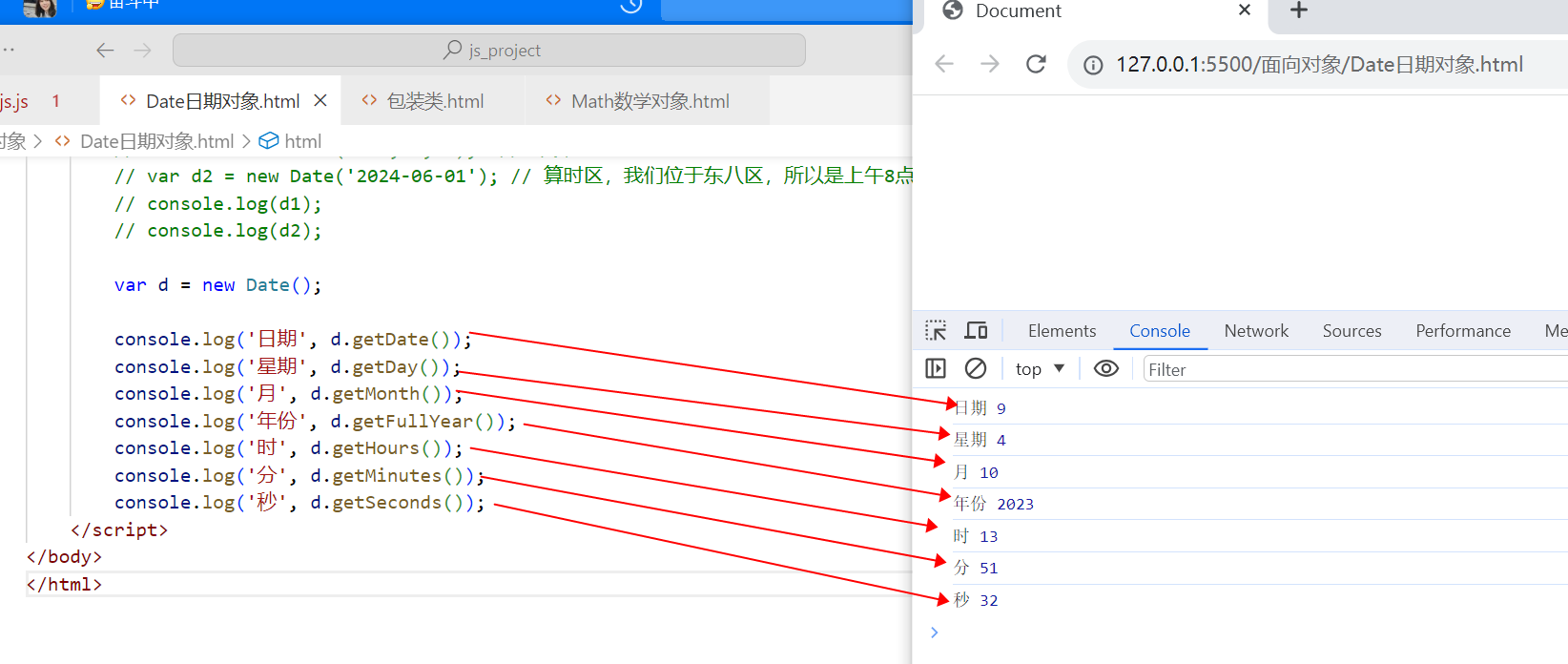
🌟 时间戳
时间戳表示1970年1月1日零点整剧离某个时刻的毫秒数
通过getTime()方法(精确到毫秒)或者Date.parse()函数(精确到毫秒)可以将日期对象变为时间戳
通过new Date(时间戳)的写法,可以将时间戳变为日期对象
示例代码:
var d = new Date();
// 显示时间戳的两种方法
var timestamp1 = d.getTime(); // 方法一,精确到毫秒
var timestamp2 = Date.parse(d); // 方法二,也是毫秒数,但后三位一定是000
console.log(timestamp1);
console.log(timestamp2);
// 把时间戳变回日期对象
var dd = new Date(timestamp1);
console.log(dd);
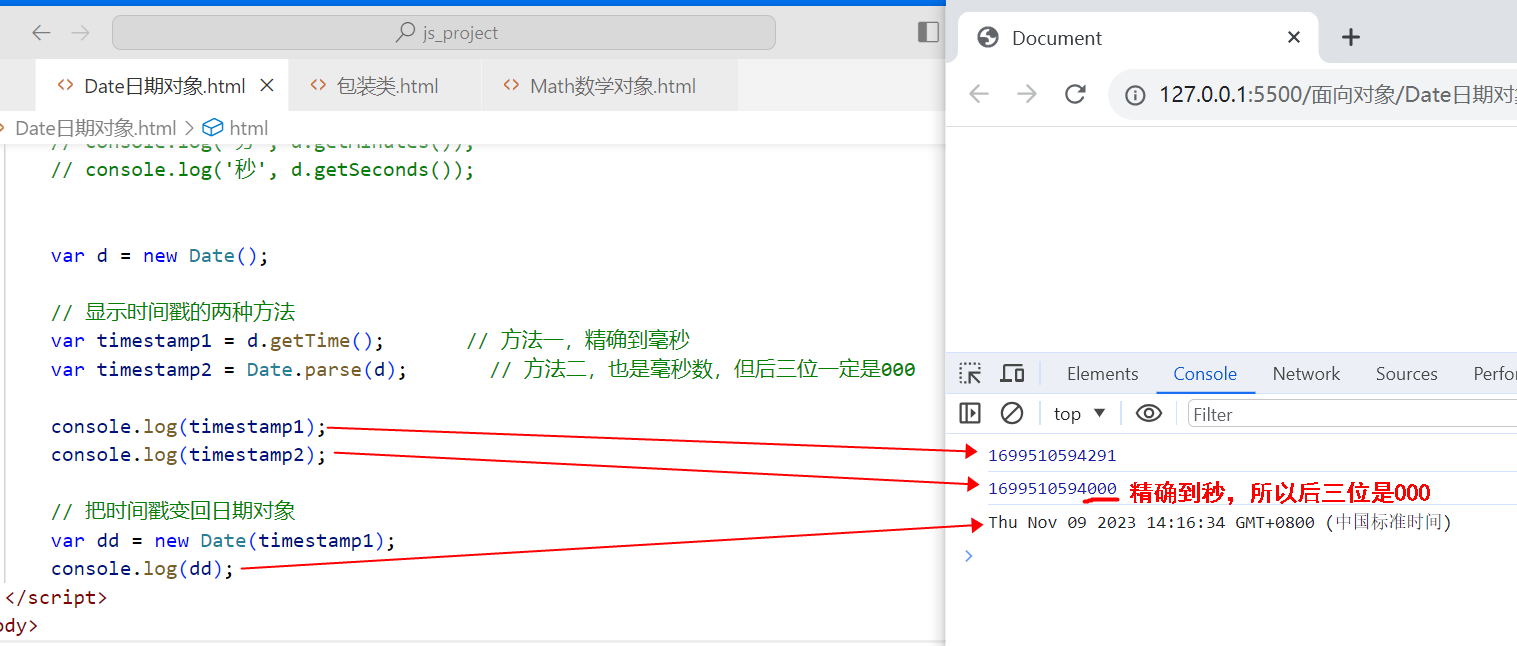
时间戳的作用: 如果数据库中只存储一个日期对象,是非常麻烦的,如果存储的是一个时间戳(整数)的方式,就会方便很多,也方便进行运算。比如如果需要比较两个时间的大小,直接转换成时间戳,再用比较运算符进行比较就可以了。
🌟 日期对象案例 - 倒计时
**案例:**在页面上显示距离2024年双十一还有多少天、多少小时、多少分、多少秒。
代码如下:
<!DOCTYPE html>
<html lang="en">
<head>
<meta charset="UTF-8">
<meta name="viewport" content="width=device-width, initial-scale=1.0">
<title>Document</title>
</head>
<body>
<h1>距2024年双十一还有:</h1>
<h2 id="info"></h2>
<script>
var info = document.getElementById('info');
info.style.color = 'red';
setInterval(() => {
// 当前时间对象
var t1 = new Date();
// 2024年双十一时间对象
var t2 = new Date('2024-11-11');
// 计算差值,得到差值的时间戳
var diff = t2 - t1;
// 将时间戳转换成天、时、分、秒
// 包含多少天?diff除以一天的毫秒数再取整,就是天数
var days = parseInt(diff / (24 * 60 * 60 * 1000));
// 包含多少小时?diff和一天的毫秒数取余,余数再除以一小时的毫秒数,再取整,就是小时数
var hours = parseInt(diff % (24 * 60 * 60 * 1000) / (60 * 60 * 1000));
// 包含多少分?除去天、小时后的余数再除以一分钟的毫秒数,再取整,就是分钟数
var minutes = parseInt(diff % (24 * 60 * 60 * 1000) % (60 * 60 * 1000) / (60 * 1000));
// 包含多少秒?出去天、小时、分钟后的余数再除以1000,就是秒数
var seconds = parseInt(diff % (24 * 60 * 60 * 1000) % (60 * 60 * 1000) % (60 * 1000) / 1000);
info.innerText = days + '天' + hours + '小时' + minutes + '分钟' + seconds + '秒';
}, 1000);
</script>
</body>
</html>

除了上述的方式外,网上还有很多计算两个时间差值的案例,可以尝试通过不同的方式实现这个功能。
本文来自互联网用户投稿,该文观点仅代表作者本人,不代表本站立场。本站仅提供信息存储空间服务,不拥有所有权,不承担相关法律责任。 如若内容造成侵权/违法违规/事实不符,请联系我的编程经验分享网邮箱:veading@qq.com进行投诉反馈,一经查实,立即删除!